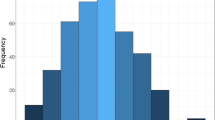Abstract
This paper examines the impact of the Chi-Chi earthquake, which hit central Taiwan on September 21, 1999, on the quality of life among the elderly survivors. The 28-item Taiwanese-adapted brief version of the World Health Organization's quality of life questionnaire (WHOQOL-BREF) was used to measure quality of life in four domains: physical capacity, psychological well-being, social relationships, and environment. These measures were coincidently collected in a separate study from 368 subjects aged 65 and older in the affected area shortly before the earthquake. Of these subjects, 268 were interviewed in a follow-up assessment 12 months after the earthquake. Linear mixed models were applied to investigate how quality of life in each of the four domains changed from the pre-earthquake assessment to 12 months after the earthquake, and how these changes depended on the level of damage to residences. In conclusion, elderly survivors tended to report lower quality of life in physical capacity, psychological well-being, and environment 12 months after the earthquake than at the assessment prior to the earthquake, regardless of the level of damage to their residences during the earthquake. However, those whose residences completely collapsed during the earthquake reported a higher quality of life in social relationships while others reported the opposite.
Similar content being viewed by others
References
Department of Health. Statistical Yearbook of the Republic of China in 1999. Taipei: Executive Yuan, Republic of China, 2000.
Directorate-General of Budget Accounting and Statistics. Statistical Yearbook of the Republic of China in 1999. Taipei: Executive Yuan, Republic of China, 2000.
Tanida N. What happened to elderly people in the great Hanshin earthquake? Br Med J 1996; 313: 1133–1135.
Peek-Asa C, Kraus JF, Bourque LB, etal. Fatal and hospitalized injuries resulting from the 1994 Northridge earthquake. Int J Epidemiol 1998; 27: 459–465.
Armenian HK, Melkonian AK, Noji EK, Hovanesian AP. Deaths and injuries due to the earthquake in Armenia: A cohortapproach. Int J Epidemiol 1998; 27: 459–465.
Abdo T, Al-Dorzi H, Jabr F, Zaghloul N. Earthquakes: Health outcomes and implications in Lebanon. Lebanese Med J 1997; 45(4): 197–200.
Kario K, Matsuo T, Kobayashi H, Yamamoto K, Shimada K. Earthquake-induced potentiation of acute risk factors in hypertentive elderly patients: Possible triggering of cardiovascular events after a major earthquake. J Am College Cardiol 1997; 29(5): 926–933.
Kloner RA, Leor J, Poole WK, Perritt R. Population-based analysis of the effect of the Northridge earthquake on cardiac deaths in Los Angeles County, California. J Am College Cardiol 1997; 30(5): 1174–1180.
Armenian HK, Melkonian AK, Hovanesianss AP. Longterm mortality and morbidity related to degree of damage following the 1988 earthquake in Armenia. Am J Epidemiol 1998; 148: 1077–1084.
Suzuki S, Sakamoto S, Koide M, et al. Hanshin-Awaji earthquake as a trigger for acute myocardial infarction. Am Heart J 1997; 134(5): 974–977.
Kario K, Ohashi T. After a major earthquake, stroke death occurs more frequently than coronary heart disease death in very old subjects. J Am Geriatr Soc 1998; 46(4): 537–538.
Carr VJ, Lewin TJ, Webster RA, Hazell PL, Kenardy JA, Carter GL. Psychosocial sequelae of the 1989 Newcastle earthquake: I. Community disaster experiences and psychological morbidity 6 months post-disaster. Psychol Med 1995; 25(3): 539–555.
Lewin TJ, Carr VJ, Webster RA. Recovery from postearthquake psychological morbidity: Who suffers and who recovers? Aust NZ J Psychiat 1998; 32(1): 15–20.
Roces MC, White ME, Dayrit MM, et al. Risk factors for injuries due to the 1990 earthquake in Luzon, Philippines. Bull World Health Organ 1992; 70: 509–514.
Huerta F, Horton R. Coping behavior of elderly flood victims. Gerontologist 1978; 15: 357–361.
Noji E. Disaster epidemiology. Emerg Med Clinics North Am 1996; 14: 289–300.
The WHOQOL-Taiwan Group. Manual of Taiwanese version of WHOQOL-BREF. Taipei: Taiwan WHOQOL Group, 2000.
The WHOQOL-Taiwan Group. Introduction to the developmentof the WHOQOL-Taiwan version. Chin J Public Health (Taipei): 2000; 19(4): 315–324.
World Health Organization. WHOQOL study protocol. Geneva: WHO (MNH/PSF/93.9), 1993.
World Health Organization. WHOQOL protocol for new centers. Geneva: WHO (MNH/PSF/94.4), 1994.
Sartorius N, Kuyken W. Translation of health status instruments. In: Orley J, Kuyken W (eds), Quality of Life Assessment: International Perspectives. New York: Springer-Verlag, 1994; 3–18.
The WHOQOL Group. Development of the World Health Organization WHOQOL-BREF quality of life assessment. Psychol Med 1998; 28: 551–558.
Sheikh JA, Yessavage JA. Geriatric depression scale (GDS): Recentfindings and development of a shorter version. In: Brink TL (ed.). Clinical Gerontology: A Guide to Assessment and Intervention. New York: Howarth Press, 1986.
Lyness JM, Noel TK, Cox C, etal. Screening for depression in elderly primary care patients. A comparison of the Center for epidemiologic studies-depression scale and the geriatric depression scale. Arch Intern Med 1997; 157(4): 449–454.
Folstein MF, Folstein SE, McHugh PR. Mini-mental state: A practical method for grading the cognitive state of patients for the clinician. J Psychiatr Res 1975; 12: 189–198.
Fillenbaum GG, Smyer MA. The development, validity, and reliability of the OARS multidimensional functional assessment questionnaire. J Gerontol 1981; 36: 428–434.
Diggle PJ, Liang KY, Zeger SL. The analysis of longitudinal data. New York: Oxford University Press, 1994.
Cnaan A, Laird NM, Slasor P. Using the general linear mixed model to analyse unbalanced repeated measures and longitudinal data. Stat Med 1997; 16: 2349–2380.
Kazis LE, Anderson JJ, Meenan RF. Effectsizes for interpreting changes in health status. Med Care 1989; 27: S178-S189.
Cohen J. Statistical power analysis for the behavioral sciences. New York: Academic Press, 1977.
Wang XD, Gao L, Shinfuku N, et al. Longitudinal study of earthquake-related PTSD in a randomly selected community sample in North China. Am J Psychiatry 2000; 157: 1260–1266.
Author information
Authors and Affiliations
Rights and permissions
About this article
Cite this article
Lin, MR., Huang, W., Huang, C. et al. The impact of the Chi-Chi earthquake on quality of life among elderly survivors in Taiwan – A before and after study. Qual Life Res 11, 379–388 (2002). https://doi.org/10.1023/A:1015543113448
Issue Date:
DOI: https://doi.org/10.1023/A:1015543113448




